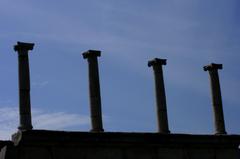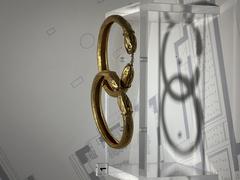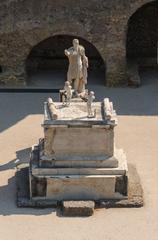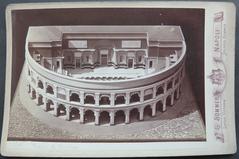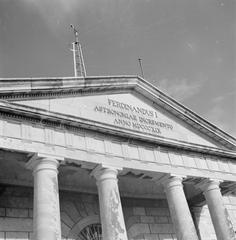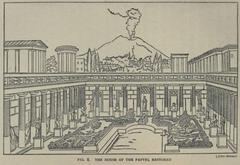Casa del Colonnato Tuscanico, Herculaneum, Italy: Visiting Hours, Tickets, and Complete Guide
Date: 14/06/2025
Introduction
The Casa del Colonnato Tuscanico—House of the Tuscan Colonnade—is one of the most significant and visually impressive residences in the ancient city of Herculaneum. With its elegant colonnaded peristyle, refined wall paintings, and evidence of shifting functions over the centuries, the house stands as a microcosm of Roman domestic and urban development. Recently reopened after extensive restoration, this domus offers an immersive journey into the life, art, and architecture of ancient Campania. This guide covers essential information for visitors—hours, ticketing, access, and travel tips—alongside detailed insights into its history, layout, artistic features, and conservation.
For up-to-date information, official ticketing, and additional digital resources, consult the Herculaneum Archaeological Park website as well as herculaneum.uk, Donovan Images, and ermakvagus.com.
Table of Contents
- Introduction
- Historical Development and Significance
- Architecture and Layout
- Cultural and Social Context
- Visiting Information
- Conservation and Research
- Highlights to See
- FAQs
- Conclusion
- Visual and Interactive Resources
- References
Historical Development and Significance
The origins of Casa del Colonnato Tuscanico date back to the Samnite period, before Roman dominance in Campania. The house began as a modest residence centered around an atrium, reflecting early Italic domestic traditions. Over time, particularly in the early 1st century CE, the house underwent significant expansion: two adjacent properties were merged, resulting in a distinctive, irregular L-shaped floor plan with dual street entrances—one on Decumanus Maximus and another on Cardo III (herculaneum.uk).
In the aftermath of the earthquake of 62 CE, further adaptation occurred: rooms facing the street were converted into commercial shops (tabernae), a pattern seen across Herculaneum and Pompeii as households responded to economic pressures and urban renewal. The house’s evolution—morphing from a private patrician residence to a mixed-use complex—mirrors broader trends in Roman society and urbanism (ermakvagus.com).
Architecture and Layout
Entrances and Atrium
Casa del Colonnato Tuscanico is accessible via two main entrances, both marked today for visitor convenience. The principal entrance on Decumanus Maximus preserves rare carbonized wooden door frames, a poignant reminder of the 79 CE eruption. Adjacent to the entrance are two shops—converted from bedrooms after the 62 CE earthquake—demonstrating the blending of domestic and commercial functions (Wikipedia).
The atrium, a central Roman domestic feature, contains a tuff impluvium (rainwater basin) later clad in marble and transformed into a decorative fountain. The space is adorned with fragments of original flooring and wall paintings, including a III Style fresco depicting a sacrificial scene with Hercules, referencing the city’s legendary founder (herculaneum.cultura.gov.it).
Peristyle and Colonnade
The heart of the house is its peristyle garden, surrounded by 17 Tuscan columns (smooth, simple capitals and bases, painted black/yellow at the base, white above). This garden is the namesake and signature feature of the house, accessible from both the atrium and a street entrance. The double-columned entrance faces a large northern room, and the portico would have provided shade and a sense of grandeur (Roman Gardens Project).
Triclinium and Wall Paintings
To the right of the peristyle lies the triclinium (dining room), the social epicenter of Roman domestic life. The walls are decorated with III and IV Style frescoes: mythological scenes featuring Bacchus and Apollo, illusionistic architecture, floral motifs, and vibrant colors (cinnabar red, deep blue, golden yellow). These reflect both the wealth and the cultural aspirations of the inhabitants (Donovan Images).
Other rooms showcase black backgrounds with delicate filigree, stylized birds, garlands, and geometric designs—hallmarks of sophisticated Roman taste.
Service Quarter and Shops
On the west side of the peristyle are the service areas: kitchen, storerooms, and a lararium (household shrine). These spaces retain painted depictions of protective serpents (agathodaimon) and functional masonry counters. The two street-facing rooms, originally bedrooms, were repurposed post-62 CE for commercial activity, illustrating the flexible use of space in response to urban change (herculaneum.cultura.gov.it).
The upper floor, now collapsed, was subdivided into four apartments after the 62 CE earthquake, accessed by a masonry staircase (now mostly gone).
Cultural and Social Context
Casa del Colonnato Tuscanico exemplifies the domus of a wealthy Roman family, yet its evolution—Samnite core, imperial expansion, commercial adaptation—reflects the dynamic, pragmatic character of Herculaneum society. Luxurious features (marble fountains, mythological frescoes, peristyle gardens) signaled elite status, while the conversion of rooms for trade after disasters underscores the resilience and adaptability of Roman urban life (ermakvagus.com).
Visiting Information
Hours and Tickets
- Opening Hours: Generally, the Herculaneum Archaeological Park—including Casa del Colonnato Tuscanico—is open daily from 8:30 AM to 7:30 PM (last entry one hour before closing). Hours may vary seasonally—always verify on the official website.
- Tickets: Entry to the house is included in the general park admission (€13 adults, €2 EU citizens 18–25, free for under-18s). Tickets are available online, at the gate, and via the Naples Pass (Along Dusty Roads).
- Closures: Some rooms or areas may be temporarily closed for conservation; check the latest updates before visiting.
Accessibility
The house is partially accessible to visitors with limited mobility: main entrances are at street level, but some interior areas (peristyle, service quarters) have uneven paving and steps. The upper floor is inaccessible. The wider park offers ramps and accessible routes; visitors with specific needs should contact staff in advance (herculaneum.uk).
Tours and Digital Resources
- Guided Tours: Both official and independent archaeologist-led tours are available, providing in-depth commentary on architecture, decoration, and social history.
- Digital Engagement: The “Ercolano Digitale” app and other digital resources offer 3D reconstructions, layered interpretations, and immersive audio guides.
- Interpretation: Informative panels (Italian/English) are placed at key points; audio guides and printed materials are available at the visitor center.
Tips for Visitors
- Best Times: Early morning or late afternoon for fewer crowds and cooler temperatures.
- Duration: Plan 30–45 minutes for the house; 2–3 hours for the full site.
- What to Bring: Comfortable shoes, sun protection, water. Photography is allowed (no flash/tripods).
- Nearby Sites: Villa of the Papyri, Suburban Baths, Hall of the Augustals, and more.
Conservation and Research
Casa del Colonnato Tuscanico has undergone extensive restoration to stabilize structures, conserve wall paintings, and improve access—part of the €45 million Progetto Domus. Early 20th-century interventions have been replaced by modern, reversible techniques: micro-injection grouts, desalination, climate monitoring, and gentle cleaning (herculaneum.cultura.gov.it; Donovan Images). The house is a focus of ongoing archaeological and scientific research, with findings shared through workshops, lectures, and digital media (Storie & Archeostorie).
Highlights to See
- Peristyle Garden: Framed by 17 Tuscan columns, with traces of original paint and marble features.
- Frescoes: Mythological scenes in the triclinium; sacrificial scene with Hercules in the former cubicolo/shop.
- Impluvium: Marble-clad basin, later transformed into a fountain.
- Lararium: Household shrine with painted serpents.
- Shops: Evidence of commercial adaptation after the 62 CE earthquake.
- Carbonized Wood: Door frames at the main entrance—a rare survival.
- Artifacts: Discoveries include a hoard of 1,400 sesterces and a bronze seal, illuminating the house’s economic history.
Frequently Asked Questions (FAQs)
Q: What are the visiting hours for Casa del Colonnato Tuscanico?
A: Typically 8:30 AM–7:30 PM; check the official website for updates.
Q: How do I buy tickets?
A: Online, at the park entrance, or via the Naples Pass. Included with general admission.
Q: Are guided tours available?
A: Yes—book official or independent tours for deeper insight.
Q: Is the site accessible for people with disabilities?
A: Partial access; some areas have uneven surfaces and steps. No access to the upper floor.
Q: Can I take photographs?
A: Yes, but no flash or tripods to protect delicate surfaces.
Visual and Interactive Resources
- Donovan Images photo collection
- Interactive Virtual Tour of Herculaneum
- Wikimedia Commons: Casa del Colonnato Tuscanico
- “Ercolano Digitale” app (available from official channels)
Conclusion
Casa del Colonnato Tuscanico is a highlight of Herculaneum, offering an unparalleled glimpse into Roman domestic architecture, art, and daily life. Thanks to ongoing conservation, digital enhancements, and guided interpretation, a visit here is rewarding for history enthusiasts, art lovers, and curious travelers alike. Check the latest hours and ticketing, plan your itinerary, and prepare for an unforgettable journey into the ancient world.
Download the Audiala app for expert audio guides, and follow official channels for updates and special events. For more travel advice and in-depth articles on Ercolano and the Bay of Naples, explore our related resources and stay connected on social media.
References and Further Reading
- Casa del Colonnato Tuscanico in Herculaneum: Visiting Hours, Tickets, and Historical Insights, 2025
- Casa del Colonnato Tuscanico: Visiting Hours, Tickets, and Artistic Highlights at Herculaneum, 2025
- Visitor Information and Experience at Casa del Colonnato Tuscanico, 2025
- Visiting Casa del Colonnato Tuscanico at Herculaneum Archaeological Park: History, Tickets & Tips, 2025
- Ercolano Riapertura Domus 2025, 2025
- Casa del Colonnato Tuscanico Frescoes and Art, 2025
- Roman Gardens Project: Casa del Colonnato Tuscanico
- Wikipedia: Casa del Colonnato Tuscanico
